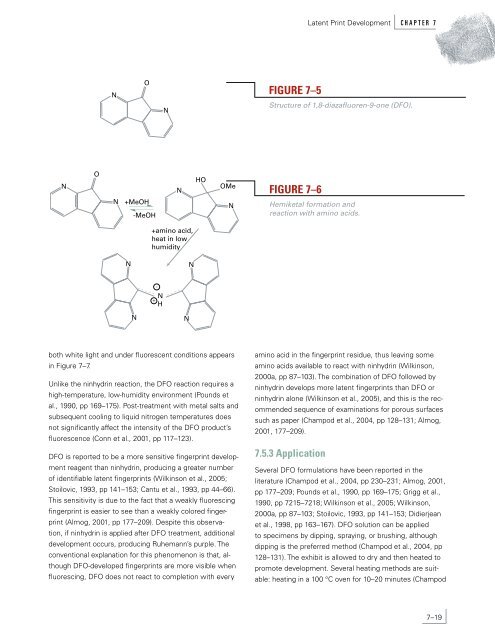Latent Print Development - National Criminal Justice Reference ...
Latent Print Development - National Criminal Justice Reference ...
Latent Print Development - National Criminal Justice Reference ...
You also want an ePaper? Increase the reach of your titles
YUMPU automatically turns print PDFs into web optimized ePapers that Google loves.
N<br />
O<br />
N<br />
N<br />
both white light and under fluorescent conditions appears<br />
in Figure 7–7.<br />
Unlike the ninhydrin reaction, the DFO reaction requires a<br />
high-temperature, low-humidity environment (Pounds et<br />
al., 1990, pp 169–175). Post-treatment with metal salts and<br />
subsequent cooling to liquid nitrogen temperatures does<br />
not significantly affect the intensity of the DFO product’s<br />
fluorescence (Conn et al., 2001, pp 117–123).<br />
DFO is reported to be a more sensitive fingerprint development<br />
reagent than ninhydrin, producing a greater number<br />
of identifiable latent fingerprints (Wilkinson et al., 2005;<br />
Stoilovic, 1993, pp 141–153; Cantu et al., 1993, pp 44–66).<br />
This sensitivity is due to the fact that a weakly fluorescing<br />
fingerprint is easier to see than a weakly colored fingerprint<br />
(Almog, 2001, pp 177–209). Despite this observation,<br />
if ninhydrin is applied after DFO treatment, additional<br />
development occurs, producing Ruhemann’s purple. The<br />
conventional explanation for this phenomenon is that, although<br />
DFO-developed fingerprints are more visible when<br />
fluorescing, DFO does not react to completion with every<br />
O<br />
+MeOH<br />
N<br />
-MeOH<br />
N<br />
- - - - -<br />
N<br />
+amino acid,<br />
heat in low<br />
humidity<br />
-- - - - N<br />
+<br />
H<br />
N<br />
N<br />
N<br />
HO<br />
OMe<br />
N<br />
FIGURE 7–5<br />
Structure of 1,8-diazafluoren-9-one (DFO).<br />
FIGURE 7–6<br />
Hemiketal formation and<br />
reaction with amino acids.<br />
amino acid in the fingerprint residue, thus leaving some<br />
amino acids available to react with ninhydrin (Wilkinson,<br />
2000a, pp 87–103). The combination of DFO followed by<br />
ninhydrin develops more latent fingerprints than DFO or<br />
ninhydrin alone (Wilkinson et al., 2005), and this is the recommended<br />
sequence of examinations for porous surfaces<br />
such as paper (Champod et al., 2004, pp 128–131; Almog,<br />
2001, 177–209).<br />
7.5.3 Application<br />
<strong>Latent</strong> <strong>Print</strong> <strong>Development</strong> C H A P T E R 7<br />
Several DFO formulations have been reported in the<br />
literature (Champod et al., 2004, pp 230–231; Almog, 2001,<br />
pp 177–209; Pounds et al., 1990, pp 169–175; Grigg et al.,<br />
1990, pp 7215–7218; Wilkinson et al., 2005; Wilkinson,<br />
2000a, pp 87–103; Stoilovic, 1993, pp 141–153; Didierjean<br />
et al., 1998, pp 163–167). DFO solution can be applied<br />
to specimens by dipping, spraying, or brushing, although<br />
dipping is the preferred method (Champod et al., 2004, pp<br />
128–131). The exhibit is allowed to dry and then heated to<br />
promote development. Several heating methods are suitable:<br />
heating in a 100 °C oven for 10–20 minutes (Champod<br />
7–19

















